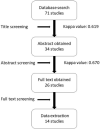Risk Factors related to Late Failure of Dental Implant-A Systematic Review of Recent Studies
- PMID: 32498256
- PMCID: PMC7312800
- DOI: 10.3390/ijerph17113931
Risk Factors related to Late Failure of Dental Implant-A Systematic Review of Recent Studies
Abstract
Resolving late failure of dental implant is difficult and costly; however, only few reviews have addressed the risk factors associated with late failure of dental implant. The aim of this literature review was to summarize the influences of different potential risk factors on the incidence of late dental implant failure. The protocol of this systematic review was prepared and implemented based on the PRISMA (Preferred reporting items for systematic reviews and meta-analyses) guideline. In December 2018, studies published within the previous 10 years on late dental implant failure were selected by fulfilling the eligibility criteria and the risk factors identified in qualified studies were extracted by using a predefined extraction template. Fourteen eligible studies were assessed. The common risk factors for late failure were divided into three groups according to whether they were related to (1) the patient history (radiation therapy, periodontitis, bruxism and early implant failure), (2) clinical parameters (posterior implant location and bone grade 4) or (3) decisions made by the clinician (low initial stability, more than one implant placed during surgery, inflammation at the surgical site during the first year or using an overdenture with conus-type connection). Clinicians should be cautions throughout the treatment process of dental implant-from the initial examination to the treatment planning, surgical operation and prosthesis selection-in order to minimize the risk of late failure of dental implant.
Keywords: PRISMA guideline; clinical parameters; decisions made by the clinician; late failure of dental implant; patient history; risk factor.
Conflict of interest statement
All authors declare that they have no conflicts of interest.
Figures
References
-
- Branemark P.-I. Osseointegrated implants in the treatment of the edentulous jaw. Experience from a 10-year period. Scand. J. Plast. Reconstr. Surg. Suppl. 1977;16:1–132. - PubMed
-
- Romeo E., Chiapasco M., Ghisolfi M., Vogel G. Long-term clinical effectiveness of oral implants in the treatment of partial edentulism: Seven-year life table analysis of a prospective study with ITI® Dental Implants System used for single-tooth restorations. Clin. Oral Implant. Res. 2002;13:133–143. doi: 10.1034/j.1600-0501.2002.130203.x. - DOI - PubMed
Publication types
MeSH terms
Substances
LinkOut - more resources
Full Text Sources


